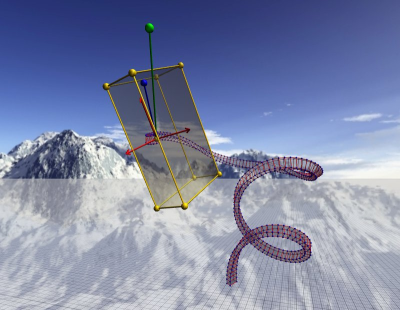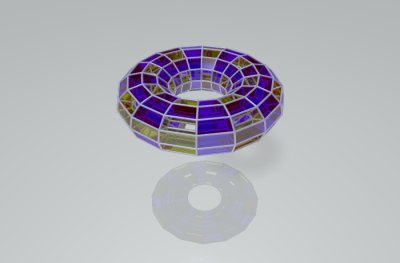| |
Home
Projects
Publications
People
Seminar
Events
Software
TU Geometry
Matheon
|
|
|
- Java Webstart Applications
To start an application (except for Polymake) just click on the screenshot. If it does not start,
have a look at our Help
page.
 |
Explore 2D and 3D cyclidic nets and associated geometric structures
(Implemented by Emanuel Huhnen-Venedey)
Cyclidic nets are a discretization of orthogonal nets, closely related to the discretization as circular nets.
In Euclidean 3-space they discretize curvature line parametrized surfaces resp. triply orthogonal coordinate systems.
The application allows to extend (fixed) 2- and 3-dimensional circular nets to cyclidic nets,
where the extension is uniquely determined by the choice of an orthonormal 3-frame at one vertex.
The user may change this frame interactively and explore the corresponding change of the cyclidic net.
The program also allows to examine single cyclidic patches and whole Dupin cyclides.
Literature
A. I. Bobenko, E. Huhnen-Venedey.
Curvature line parametrized surfaces and orthogonal coordinate systems: discretization with Dupin cyclides
Geometriae Dedicata Vol. 159, Issue 1 (2012), 207-237
(online).
|
|
 |
Construction of discrete minimal surfaces with boundary conditions
(Implemented by Stefan Sechelmann)
Construct discrete minimal surfaces from the combinatorics of their curvature lines. A detailed
description is contained in the Diploma Thesis of Stefan Sechelmann.
Literature
S. Sechelmann.
Discrete Minimal Surfaces, Koebe Polyhedra, and Alexandrov's Theorem.
Variational Principles, Algorithms, and Implementation. Diploma Thesis
unpublished
(online).
A. I. Bobenko, T. Hoffmann, and B. A. Springborn.
Minimal surfaces from circle patterns: Geometry from combinatorics
Annals of Mathematics 164 (2006), 231-264
(online).
A. I. Bobenko, B. A. Springborn.
Variational principles for circle patterns and Koebe's theorem.
Trans. Amer. Math. Soc. 356 (2004), 659-689
(online).
|
|
 |
Construction of a convex polytope from a given development
(Implemented by Stefan Sechelmann)
For any convex polyhedral metric on the sphere there exists a unique convex
polytope that has this metric on its boundary.
Usage:
In the left half of the window draw a triangulation and assign lengths to the
edges. Start the calculation. If your data defines a convex polyhedral metric,
then in the right half of the window you will see the convex polytope.
Literature
A. I. Bobenko, I. Izmestiev.
Alexandrov's theorem, weighted Delaunay triangulations, and mixed
volumes. Preprint
arXiv:math.DG/0609447, 2006.
|
|
 |
Construction of the Koebe polyhedron for a given 3-connected planar graph
(Implemented by Stefan Sechelmann)
For each combinatorial type of convex 3-dimensional polyhedra, there exists a
unique representative with the following properties:
- All edges are tangent to the unit sphere.
- The barycenter of the points where the edges touch the sphere is the origin.
This application constructs this Koebe polyhedron for a given
3-connected planar graph.
Literature
A. I. Bobenko, B. A. Springborn.
Variational principles for circle patterns and Koebe's theorem.
Trans. Amer. Math. Soc. 356 (2004), 659-689
(online).
B. A. Springborn.
A unique representation of polyhedral types. Centering via
Möbius transformations. Math. Z. 249:3 (2005),
513-517 (online).
B. A. Springborn.
Variational principles for circle patterns.
PhD thesis, Technische Universität Berlin, 27 Nov 2003.
Supervisor: A. I. Bobenko.
Published online.
Errata page [PDF].
|
|
 |
Program for the 3D visualization of a rigid body motion around a fixed point in a homogeneous gravity field at the example of quader. It includes the construction of the special cases of Kowalewski and Goryachev-Chaplygin, displays their integrals of motion and visualizes their corresponding elastic rods. Further it includes the possibility to compare different discretizations of the paths of lagrange tops, i. e. the integrable discretization developed in [1] and a numerical one.
For a complete description of content, usage and functionality see [2].
Besides the java web start there is a zip
archiv of a stand alone version (Windows or Linux) of the program
Literature
[1] A. I. Bobenko and Yu- B. Suris, A Discrete Time Lagrange Top and Discrete Elastic Curves,
Amer. Math. Soc. Transl. (2) Vol. 201, 2000.
[2] René Bodack, Dynamics of the Spinning Top: Discretization and Interactive Visualization,
Diploma Thesis, unpublished (online).
|
- Polymake
 |
Polymake started out as a tool for the algorithmic treatment of
convex polyhedra. By now it also deals with finite simplicial complexes,
tight spans of finite metric spaces, polyhedral surfaces, and other
objects.
Literature
Polymake: a framework for analyzing convex polytopes,
(Ewgenij Gawrilow, Michael Joswig).
In Polytopes - Combinatorics and Computation,
Birkhäuser, 2000, pp. 43-74,
(Gil Kalai und Günter M. Ziegler, Eds.)
Drawing Polytopal Graphs in polymake,
(Ewgenij Gawrilow, Michael Joswig, Thilo Rörig und Nikolaus Witte).
Preprint arXiv:0711.2397, 2007
|
|
- Links
-

|



